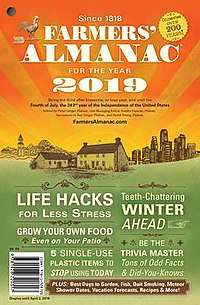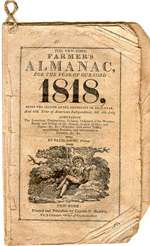Farmers' Almanac
 Cover of the 2019 Farmers' Almanac | |
| Editor Managing Editor |
Peter Geiger Sandi Duncan |
|---|---|
| Former editors |
Ray Geiger William Jardine Berlin Hart Wright Samuel Hart Wright David Young |
| Categories | Almanacs |
| Frequency | Annually |
| Publisher | Almanac Publishing Company |
| First issue | 1818 |
| Company | Geiger |
| Country |
|
| Language | English |
| Website |
www |
| ISSN | 0737-6731 |
Farmers' Almanac is an annual North American periodical that has been in continuous publication since 1818. Published by Geiger of Lewiston, Maine, the Farmers' Almanac provides long-range weather predictions for both the U.S. and Canada, informative and quirky articles, tips, and valuable calendars, and information on everything from the best days to garden, fish, view planets and meteor showers, and take vacations, to full moon dates and lore, and ways to use natural remedies and life hacks for a healthier, less-stressful life.
Each new year’s edition is released at the end of August of the previous year and contains 16 months of weather predictions broken into 7 zones for the continental US as well as seasonal weather maps for the winter and summer ahead.
In addition to the U.S. version, there is a Canadian Farmers’ Almanac and a Promotional Version that is sold to businesses as a marketing and public relations tool.
History
Founded in 1818, the Farmers’ Almanac’s timeless appeal has spanned three centuries, offering readers a trademark blend of long-range weather predictions, humor, fun facts, and valuable advice on gardening, cooking, fishing, conservation, and much more.
The Farmers’ Almanac has had seven editors. Poet, astronomer, and teacher David Young, Philom., held the post for 34 years from the day he and publisher Jacob Mann first founded The Almanac Publishing Company in Morristown, New Jersey. Following Young’s death in 1852, a string of successors took the helm, beginning with astronomer Samuel Hart Wright.
In 1933 Ray Geiger took over as the sixth editor of the Farmers’ Almanac and began what became the longest-running and most colorful editorship in Farmers’ Almanac history.
In 1994, upon completion of his 60th consecutive edition, Ray passed the editorial reins onto his son, Peter, who had been serving as Associate Editor for 15 years. Peter, who also serves as Executive Vice President of Geiger, hired Sandi Duncan to serve as Managing Editor with him. Sandi was the first woman editor in 178 years to hold an editorial position.
Weather prediction

Predictions for each edition are made as far as two years in advance. The U.S. retail edition of the Farmers' Almanac contains weather predictions for 7 U.S. climatic zones, defined by the publishers, in the continental United States, broken into 3-day intervals. Seasonal maps and summaries for each season are also shared in each new edition, as are forecasts for annual sporting events. Predictions cover 16 months, from the previous September (through December of the publication year).
The Farmers' Almanac will only state publicly that their method is an “exclusive mathematical and astronomical formula, that relies on sunspot activity, tidal action, planetary position and many other factors." The Almanac's forecaster is referred to by the pseudonym Caleb Weatherbee. According to the publishers, the true identity of the forecaster is kept secret to prevent him or her from being "badgered."
Accuracy
Publishers point to "many longtime Almanac followers claim that their forecasts are 80% to 85% accurate" on their website. Their website also contains a list of the many more “famous” weather predictions they have accurately forewarned of and like to point out that they’ve been predicting the weather longer than the National Weather Service.
In addition to the popular U.S. version, there is also the Canadian Farmers' Almanac and a branded promotional version that businesses can personalize and distribute to customers. The total annual distribution of all Farmers' Almanac editions is more than 2 million copies.
Online
Bringing the wisdom of the ages into the digital age, in 1997 FarmersAlmanac.com was created as a way to share the Almanac’s content digitally. Today it is one of the most popular sites for people of all ages to access long-range weather predictions, and learn when the best days are to plant your garden, go fishing, find the date of the full moon, or quit a habit.
Social Media
The Farmers’ Almanac’s popularity continues to grow digitally. The Almanac has over 1.2 million followers on Facebook, and a strong following on Twitter, Instagram, Pinterest and other social media sites.
Notable articles
Most editions of the Farmers' Almanac include a "human crusade," advocating for a change in some accepted social practice or custom. Previous crusades have included: "How Much Daylight Are We Really Saving," a recommendation for a revised Daylight Saving Time schedule (2007); "Why is Good Service So Hard to Schedule," recommending that service providers offer more specific timeframes when scheduling home visits (2006); "A Kinder, Gentler Nation," urging readers to exercise more common courtesy (2003); "Saturday: The Trick to Making Halloween a Real Treat," advocating that the observance of Halloween be moved to the last Saturday in October (1999); "A Cure for Doctors' Office Delays," demanding more prompt medical service and calling for a "Patients' Bill of Rights" (1996); and "Pennies Make No Sense," which sought to eliminate the penny, and to permanently replace the dollar bill with less costly-to-produce dollar coins (1989).[1]
Other pieces that have attracted attention over the years include:
- Farmers' Almanac's 2010 list of the "5 Worst Weather Cities"[2] which elicited a call for retraction from syracuse.com[3] after naming the Central New York city as the worst winter weather city.
- The 2014 Winter Outlook[4] which called for a winter storm to hit just about the time Super Bowl XLVIII was to be played at MetLife Stadium in New Jersey (no such storm materialized, and the weather was actually warmer than average at the time of the event).[5]
- The 2001 campaign to name an official National Dessert (readers resoundingly responded in favor of traditional apple pie).
Popular culture
A "farmer's almanac" has been referenced in numerous television shows and movies, including The Office, MASH, Twin Peaks, The Dukes of Hazzard, Wings, Cold Case, The Last Starfighter, and Father of the Bride. Popular culture does not always distinguish between the Farmers' Almanac and the older Old Farmer's Almanac, so it is not always clear to which publication a particular reference is meant to allude.
The Old Farmer's Almanac was used in Young Mr. Lincoln, a movie about the future president starring Henry Fonda. Lincoln referenced the Almanac as a young lawyer in a court case that helped to acquit his client.
Country singer Randy Travis has a song titled "The Family Bible and The Farmer's Almanac" on his CD A Man Ain't Made of Stone. The song is about his farmer grandfather and what a wise man he was, yet the only two books he owned were the ones told in the title. He got all the life advice he needed from those two books.
References
- ↑ "Pennies Make No Sense But A 12½-Cent Coin Makes A Bit". farmersalmanac.com/. Almanac Publishing Company. 1989. Retrieved 27 August 2013.
- ↑ Weatherbee, Caleb. "5 Worst Winter Weather Cities". Farmers' Almanac. Almanac Publishing Company. Retrieved 25 March 2014.
- ↑ "Hey Farmers' Almanac, we demand a retraction. Syracuse is a Winter wonderland". syracuse.com. Retrieved 25 March 2014.
- ↑ Weatherbee, Caleb. "The "Days of Shivery" are Back! Read Our 2014 Forecast!". Farmers' Almanac. Almanac Publishing Company. Retrieved 2 December 2013.
- ↑ Belson, Ken. "Almanacs Foresee a Super Bowl to Test Fans' Resolve, and Snow Gear". The New York Times. Retrieved 2 December 2013.